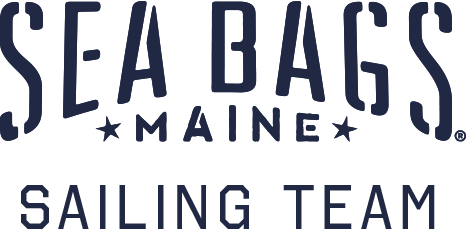J/24 Nationals
In a loaded field of 42 boats, the Sea Bags Women’s Sailing Team finished 12th, originally tied for 11th but ultimately decided by a tie breaker, only six points out of 9th place. We sat down with Erica and Emily to chat about the SBWST’s weekend race.
Sea Bags: How did this weekend’s regatta go? How did it progress you towards the team’s goals?
Our performance goals as a team for the 2023 season were put to the test in an uncharacteristically early season U.S. National Championships, held at the Lake George Club in New York on May 18-21. With Nationals, a top-level regatta, the team was eager to put into play all that we had learned in a series of virtual coaching sessions with sailing pro Mike Ingham over the winter, capped off by a day of in-person coaching on Lake Canandaigua at the JDaze regatta earlier in the month. Throughout the Nationals event, we were focused on executing a new starting routine, leveraging new instruments, and focused on a time and distance calculation. Specifically, our primary goal for this race and others, is to get off the starting line with speed, in a low-density spot, ideally near the favored end of the line in the first row. Secondarily, we focused on sailing with optimal heel angle (which is how far the boat tips over when sailing up wind) in all conditions, ensuring better point and speed around the course. All our goals hinge on improving role clarity and communication, critical to implementing the new start plan effectively as we shift away from former practices.
What are your favorite memories of J/24 Nationals in prior seasons?
We have had a series of three fantastic Nationals events in a row in recent years. In 2022, we did not go to Texas to compete in Nationals due to the distance and time required. The year prior, in 2021, we raced on Lake Champlain in Vermont and placed 14th, a great showing at a heavy air regatta. In 2019, prior to the start of the pandemic, Nationals was hosted by Rochester Yacht Club in New York. We placed 13th in that event, working hard to manage shifty and light to medium air conditions with big rollers on Lake Ontario.
What is the Lake George course/venue like for racing?
Lake George sits within the Adirondack Mountains, offering a spectacular backdrop for racers on the lake. It is a long and narrow lake, carved by glaciers, running north to south. As lake sailing goes, it is typical to have shifty conditions, with wind velocity moving up and down as well as directional changes throughout the day. Given its location in a mountainous region, Lake George often presents what sailors call “cat’s paws”—sudden puffs or zephyrs that seem to drop out of the sky unexpectedly and often threaten auto-tacks or wet feet for those hiking on the rail.
How does it differ from Canandaigua earlier this month?
Canandaigua Lake, in the Finger Lakes in upstate New York, is not surrounded by mountains. It is set in hilly farm country, and while it can be as shifty as Lake George, it is not nearly as common. Canandaigua also tends to be less breezy and is more affected by early morning and late day temperature changes on land. During the JDaze event we were really focused on shaking off our winter rust, remembering how to sail the boats well. Unfortunately, most of our races there were drifters, races where we barely moved. At Nationals we had winds of all strengths which really challenged all teams to show their ability to shift gears between wind strengths. Those who could sail fast in all conditions ended up at the top of the podium. At Canandaigua there were 18 boats, at Nationals we had 42 boats. Two totally different sized fleets.
Can you walk us through what it takes to get the team out on the water and ready to race?
As we prepare for an event, there is significant work to ready the boat itself as well as pull together all the necessary documentation, team gear, and equipment. Boat prep centers on cleaning the hull to ensure minimal friction in the water, including cleaning, waxing, wet sanding, and buffing from keel up to the waterline. We also clean the decks and ensure all sails, lines, and required equipment are on board. Large events often require that crew weigh in (max combined weight in the J/24 class is 882 lbs.), sails be measured, and that mast and standing rigging are measured to ensure all conform to class rules and requirements. We also need to ensure instruments, radios, and the Torqueedo electric engine battery are charged up—as well as the GoPro so that we can capture footage on the water! Team logistics include getting the whole team together—from Portland, Maine, to San Francisco, California, and anywhere in between! We coordinate when we and the boat need to arrive so we can launch in time for practice races the afternoon before an event begins. We're fortunate to have a teammate, Joy Martin and her husband John Baker who are retired and can transport the boat from point A to point B. All team members need to step up to take on some of the workload. It is amazing how much effort goes into an event.
Looking ahead to the rest of the season, what’s on the horizon?
Skipper Erica says, "I never really dreamed that a top ten finish at a Nationals or North Americans was in our reach because we do not race with professionals on board, but after this event, and seeing the way the team worked together and put into place the lessons gleaned from Mike Ingham, it is absolutely in our reach. Our next event is North Americans in Ohio in August, and a top ten overall finish is something we have our eyes set on."



